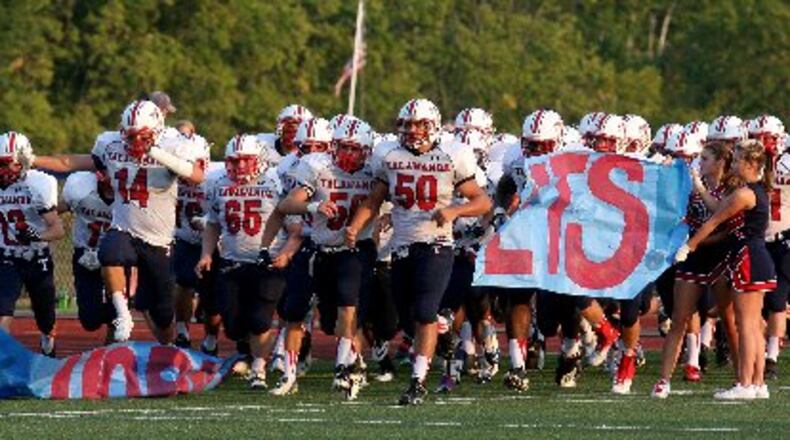Revenue from each sport that goes to the Ohio High School Athletic Association
$13,085,000: Projected total revenues and expenses for 2013-14.
$4,508,000: Projected revenue from football.
$2,294,000: Projected revenue from boys basketball.
$6,283,000: Projected revenue from all other 18 sports combined.
This week’s kickoff of high school football season brings its annual economic shot in the arm for school athletic budgets and - if the teams win - is counted on to add everything from community spirit to levy support.
High school football has the greatest athletic-generated financial impact on local school districts. Area games this week are expected to draw more than 100,000 spectators. Some districts with winning traditions, such as Centerville and Coldwater in Mercer County, have long-running football programs and expect the revenue from football to financially sustain nearly all of their other sports.
Other schools, like Miamisburg, have winning and losing seasons and are hoping for the good things that come this year from a strong performance. Miamisburg last season ended a decade of decline and won seven games, its first under new coach Steve Channell, and parlayed that into sponsorships for a new stadium scoreboard.
“The mood around town is electric,” Miamisburg athletic director Jason Osborne said. “I can’t go anywhere without someone wanting to talk football.”
Crowds fluctuate, but nothing brings people out more than a team playing a close rival in which travel is not a factor on a night with good weather. Most local schools host five games and travel for five games. Hosting a first-round playoff game – which goes to the higher seed – brings in even more.
Centerville Stadium can seat about 8,000 spectators and fit another 2,000 in both end zones. Elks AD Rob Dement said that Centerville typically can generate $15,000 to $25,000 for a single home football game against a high-profile opponent. Expenditures such as security, police, cleanup and workers account for about $5,000. Over the season that can mean anywhere from $50,000 to $100,000 for the athletic program
“The revenue that’s generated from football is vital to what our athletic programs are able to provide,” Dement said.
“(Football) sets the table; no doubt about it. Not just athletically, but in the overall climate within the school and community. Obviously, when the football team is enjoying a great season it just helps everything else fall in line.”
Coldwater has qualified for the football playoffs in all of Eric Goodwin’s 16 years as the Cavaliers’ AD. He estimated that the program generates $75,000 a season.
The Coldwater football stadium seats 5,000 and can hold another 1,000 standing room only. That’s far more than the population of the communities the Cavs play.
The Cavs are the defending Division V state champs. Its rival, Marion Local, located just 12 miles away, has won the last two D-VI titles.
“It’s like they always say, you want to run a (school) levy when you win a state title,” Goodwin said. “Basically, what that’s saying is everybody’s spirits are a lot higher whenever you’re winning. Football reaches so many people. When you are winning it’s a community thing and everybody’s pretty proud and everybody gets into it.”
Goodwin said Coldwater tries to parlay the financial success of the football team to support the entire athletic program. Goodwin is adamant about equally spreading the wealth among all sports.
Miamisburg’s Harmon Field has been in use since 1896 and the Vikings long ago outgrew its 2,700 capacity seating.
A rare winning season last fall helped generate enough community interest to upgrade the storied grounds with a state-of-the-art Side Effects scoreboard and LED message center. Kettering Sports Medicine, Kroger, Skyline Chili, Code Credit Union, El Rancho Grande, Liberty Tax Service, Millennium Metals, Smoothie King, Milan’s and the Walker Auto Group all wanted in as sponsors. Once it’s paid off, the school will share with Side Effects annual revenue from the sponsors.
“The interest a high school football program creates also creates the opportunity for sponsorships which in turn becomes a key component in generating revenue for the entire athletic department,” Osborne said.
Football is also a giant money maker for the Ohio High School Athletic Association, which administers the leagues and rules for most Ohio high school sports.
The OHSAA has a projected budget of $13,085,000 for the 2013-14 school year. Of that, more than one third ($4,508,000) is generated from the football postseason. The next highest OHSAA sport is boys basketball ($2,294,000), nearly half of what football generates. None of the other 18 sports come close to those two.
“Football is so wildly popular and has such a large fan base, that does lend itself to being the sport that brings in the most revenue,” said Tim Stried, the OHSAA’s Director of Information Services.
And partly because football can generate more revenue than any other sport, OHSAA this year is expanding the football playoffs to seven divisions from six. The move allowed an additional 32 schools to play in the postseason.
“It’s a pretty nice system,” Stried said. “We look at that as a sign of strong communities. It’s almost a phenomenon. It’s not this way throughout the country, but in Ohio whole towns will go to a single event on a Friday or Thursday or Saturday night, whenever they happen to play. It’s special.”
About the Author
